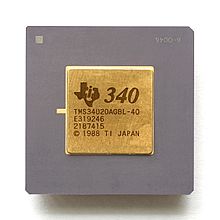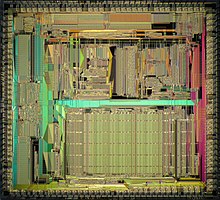TMS34010

TheTMS34010,developed byTexas Instrumentsand released in 1986, was the first programmablegraphics processorintegrated circuit.While specialized graphics hardware existed earlier, such asblitters,the TMS34010 chip is amicroprocessorwhich includes graphics-oriented instructions, making it a combination of aCPUand what would later be called aGPU.It found use inarcade video gamesfrom the late 1980s through the mid 1990s, includingMortal KombatandNBA Jam,and computer workstation video accelerator boards. TI later released the TMS34020 with an emphasis on 3D rendering.
History
[edit]The design of the TMS34010 was led by Karl Guttag, who previously worked on theTMS9918video chip.[1]Development took place at TI facilities inBedford(UK) andHouston(US). Firstsiliconwas working in Houston in December 1985, with shipment of development boards toIBM's workstation facility inKingston, New York,in January 1986.
Midway Games[a]was a prolific user of the chip inarcade video gamesbeginning with the run and gunNarcin 1988. Subsequent releases includeSmash TV(1990),Mortal Kombat(1992), andNBA Jam(1993). The 3D driving simulatorHard Drivin'(1989) fromAtari Gamescontains two of the processors.[2]Atari Games used the chip in other flat-shaded 3D games:S.T.U.N. Runner(1989),Race Drivin'(1990), andSteel Talons(1991).
TI developed theTexas Instruments Graphics Architecture(TIGA) specification for professional-level video accelerator cards forIBM PC compatibles,of which the TMS34010 was central.[3][4]
A follow-up processor, theTMS34020,can be used with afloating pointcoprocessor to render three-dimensional graphics. It is used in Midway's 1994Revolution X,even though the game is not fully 3D.[5]
Technical details
[edit]The TMS34010 is abitaddressable, 32-bit processor, with tworegister files,each with fifteen registers and sharing a sixteenthstack pointer.[6]The instruction set supports drawing into two-dimensional bitmaps, arbitrary variable-width data, conversion of pixel data to different bit depths, and arithmetic operations onpixels.Positions in bitmaps can be specified either as X, Y coordinates or as addresses. ThePIXBLTinstruction handles drawing pixels, including Boolean and other operations for combining pixel data, and most of the microcode for graphics functions is to support it.[7]
The TMS34010 can execute general purpose programs and is supported by anANSI Ccompiler. Most of the arcade video games that use the processor were written in nativeassembly language,not C.
Uses
[edit]Arcade video games
[edit]The TMS34010 is used in many coin-operatedarcade video gamesmanufactured from 1988–1997.[8]Several games use the TMS34020.
Atari Games
- Hard Drivin'(1989) Uses two TMS34010 chips: one for rendering and one for simulation.[2]
- S.T.U.N. Runner(1989)
- Race Drivin'(1990)
- Steel Talons(1991)
Williams / Midway
- NARC(1988)
- Smash TV(1990)
- Trog(1990)
- High Impact Football(1990)[9]
- Strike Force(1991)
- Super High Impact(1991)
- Terminator 2: Judgment Day(1991)
- Total Carnage(1992)
- Mortal Kombat(1992)
- Mortal Kombat II(1993)
- NBA Jam(1993)
- Revolution X(1994)[5]Uses TMS34020.
- Mortal Kombat 3(1995)
- Ultimate Mortal Kombat 3(1995)
- WWF WrestleMania(1995)
- NHL: 2-on-2 Open Ice Challenge(1995)
- NBA Hangtime(1996)
- NBA Maximum Hangtime(1996)
- Rampage World Tour(1997)
MicroProse Games
- F-15 Strike Eagle(1991)
- B.O.T.S.S. - Battle of the Solar System(1992)[10]
Other
- AmeriDarts(1989)[11]
- Battletoads(1994) Uses TMS34020.
Video accelerators
[edit]The TMS chips are compliant with the 1989Texas Instruments Graphics Architecture(TIGA) standard, and in the early 1990s were used in professional-level video coprocessor boards forMS-DOS,Microsoft Windows,andSCO Unix.[3]In a 1991 article on graphics adapters,PC Magazinereported that the fastest boards for regeneratingAutoCADtest images were based on the TMS34010.[4]
TheAura Scuzzygraph,[12][13]Radius PowerView,[13]andRadius SuperView[13]externalSCSIgraphics cards forApple Macintoshcomputers are based on the TMS34010.
One of the graphics options for the 1988Sun386iworkstation, the CG5 video card, uses the TMS34010.[citation needed]
The AmigaA2410graphics card uses the TMS34010 and was sold inCommodore AmigaUNIX workstations, the Amiga 2500UX and 3000UX.[14]It was developed in conjunction with theUniversity of Lowell.When running Amiga UNIX, the card supports theX Window Systemand gives a high resolution 8-bit display. The card can also be used when runningAmiga OS,with support libraries and someRetargetable Graphicsimplementations.
Game console
[edit]In 1987, TI demonstrated real-time 3D games withstereo soundeffects on apersonal computer,using a small TMS34010 adapter card called"The Flippy".[15]The Flippy was designed as the basis of a game development system for consoles and as an IBM PC compatible gaming card in its own right. Texas Instruments engineer Michael Denio wroteThe Adventures of Captain Pixelas a demo for the system.[15]In 1988, he released a similar game,The Adventures of Captain Comic,as shareware for MS-DOS.
TI made an unsuccessful effort in 1987 and 1988 to convince games makers such asNintendoandSegato write 3D games and create a newconsolemarket.[citation needed]
TMS34020
[edit]

The successor to the TMS34010, the TMS34020[16](1988), provides several enhancements including an interface for a special graphicsfloating pointcoprocessor, the TMS34082 (1989). The primary function of the TMS34082 is to allow the TMS340 architecture to generate high qualitythree-dimensionalgraphics. The performance level of 60 millionverticesper second was advanced at the time.
The TMS34020 is used in some arcade games, such asRevolution X(1994).[17]
TheRambrandtAmigaextension card fromProgressive Peripherals & Softwaresupported up to four TMS34020, for use invirtual realitysimulations.[18]
Notes
[edit]- ^Initially the restartedWilliams Electronicsdivision of Midway.
References
[edit]- ^"Busting, Sony's Ghostbusters AR Display (and a Little Sprite History)".Karl Guttag on Technology.October 24, 2019.
- ^abMargolin, Jed."Schematics For Hard Drivin'/Race Drivin' ADSP, Motor Amplifier, and DSK Boards".
- ^abInfoWorld Media Group, Inc. (16 December 1991).InfoWorld.InfoWorld Media Group, Inc. p. 32.
- ^abPoor, Alfred (June 25, 1991)."Cover Story: Graphics Adapters".PC Magazine.
- ^ab"Revolution X".Arcade History.
- ^"TMS34010 Product Specs".
- ^Killebrew Jr., Carrell R. (December 1986)."The TMS34010 Graphics System Processor".Byte.Vol. 11, no. 13. p. 193.
- ^"MAME list of TMS34010 emulated games".
- ^"High Impact Football".Arcade History.
- ^"B.O.T.S.S. - Battle Of The Solar System".arcade-history.com.
- ^"AmeriDarts arcade video game".Arcade History.
- ^"GYPSI Debugger Beta testers wanted".www.verycomputer.com.Retrieved2022-12-15.
- ^abc"PowerView SuperView - PiSCSI/piscsi GitHub Wiki".github-wiki-see.page.Retrieved2022-12-15.
- ^"Commodore A2410 - Amiga Hardware Database".amiga.resource.cx.Retrieved2020-09-01.
- ^abThe Adventures of Captain Pixel,retrieved2022-12-15
- ^"TMS34020 Product Specs".
- ^"Revolution X, arcade video game by Midway".Arcade History.
- ^"PPS Rambrandt".
- "TI's TMS34020 Graphics System Processor". (31 October 1990).Microprocessor Report.
